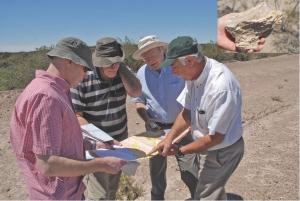VANCOUVER — With over 4,000 sq. km of prospective uranium property and guidance from a geologist with more than two decades of uranium experience in the country, Blue Sky Uranium (BSK-V, BKUCF-O) hopes to lead a uranium exploration resurgence in Argentina.
Blue Sky’s uranium portfolio has blossomed over the last year. In April 2007 the junior inked a deal with Argentina Uranium, paying US$65,000 for exclusive rights to acquire properties within the privately held company’s large portfolio.
Out of the ensuing 90 days of due diligence came two joint-venture agreements: Blue Sky optioned 75% of the Santa Barbara and Anit projects, both in Rio Negro province in the northern portion of the Patagonia region of Argentina. But the company must have seen even more potential in Argentina Uranium’s 5,000-sq.-km uranium land package and, in February of this year, acquired the company.
Along with Argentina Uranium’s extensive land package, Blue Sky gained the expertise of Jorge Berizzo in the acquisition. Berrizo spent 14 years as a senior uranium geologist for the Argentine government. In the 1970s, he put together a detailed regional uranium exploration plan for the country, though insufficient funds prevented the government from executing the plan at the time. Berizzo also discovered the 10-million-lb. Cerro Solo uranium deposit in Chubut province, Argentina.
At the 600-sq.-km Santa Barbara project, a first-phase reconnaissance sampling and surveying program identified three radiometric anomalies. One of the anomalies is 11 km long, the second stretches 6 km, and the third runs for 5 km; all three are roughly 1 km wide. Grab samples from the discovery area returned grades of up to 1.34% U3O8.
Uranium mineralization at Santa Barbara is hosted by continental fluvial Upper Cretaceous calcite-cemented conglomerate and sandstone interlayered between limonitic mudstones with high gypsum. In general, the rocks are undeformed and subhorizontal, in an area of subdued topography.
Over at the 1,287-sq.-km Anit property, an airborne radiometric survey identified a 15-km-long, 1- km-wide uranium anomaly. In following up the anomaly on the ground, Blue Sky found rock samples with visible uranium mineralization exposed by a freshly graded gravel road that runs through a section of the anomaly.
Anit is a grassroots uranium discovery. It’s a sandstone-hosted environment similar to the Grants uranium district in New Mexico, which has produced more than 340 million lbs. uranium.
Blue Sky is currently advancing exploration programs at both Santa Barbara and Anit consisting of overburden augur sampling to a 3-to 5- metre depth, radon gas analysis, ground geophysics, geological mapping, and trench chip sampling. The programs are expected to wrap up in May.
In addition to its Argentinean properties, Blue Sky is exploring the Eagle Lake and Karin Lake properties, working to earn a 60% interest in each from joint-venture partner Eagle Plains Resources (EPL-V, EGPLF-O). The projects are located 35 km east of Cameco’s (CCO-T, CCJ-N) Key Lake mine in north-central Saskatchewan. The claims lie just south of the edge of the Athabasca formation, underlain by basement rocks of the Wollaston domain.
Exploration programs in the 1970s identified uranium showings in the Eagle Lake-Karin Lake area, with samples grading as high as 8% U3O8. Currently, the main focus is an area called Craig Bay, where a highly anomalous rock face sits at the margin of a 27-km-long conductive EM ring feature, all within the claim area.
A 1,500-metre drill program is under way at the projects to test the Craig Bay showing and to probe a strong section of the electromagnetic conductor, 2 km in length. The conductor coincides with a pronounced topographic lineament associated with yellow and red-stained mineralized boulders grading up to 0.93% U3O8.
Blue Sky recently traded around the 45 mark. The company has a 52-week trading range of 32-$1.25 and has 17.1 million shares issued.


Be the first to comment on "Blue Sky sees uranium potential in Argentina (April 14, 2008)"